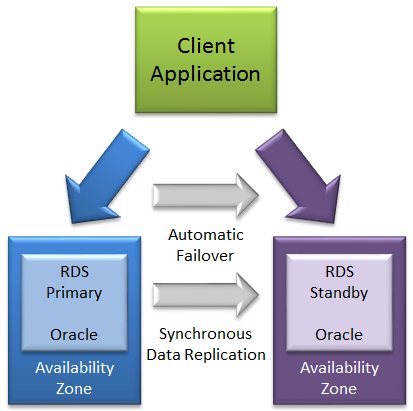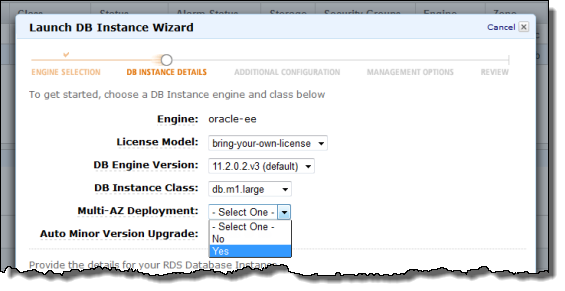AWS News Blog
Multi-AZ Option for Amazon RDS for Oracle Database
The Multi-AZ (Availability Zone) feature of the Amazon Relational Database Service (RDS) replicates database updates across two Availability Zones to increase durability and availability. Amazon RDS will automatically fail over to the standby for planned maintenance and unplanned disruptions:

This feature is now available for all license types supported by Amazon RDS for Oracle Database including Standard Edition and Standard Edition One, and can be enabled with a single click, for new and existing RDS DB Instances:

In order to work properly with a Multi-AZ DB Instance, your application must be able to reconnect to the instance after a failover. We’ve added a new option to the rds-reboot-db-instance command to allow you to trigger a failover. You can also do this from the AWS Management Console.
When automatic failover occurs, your application can remain unaware of what’s happening behind the scenes. The CNAME record for your DB instance will be altered to point to the newly promoted standby. Your client library must be able to close and reopen the connection in the event of a failover.
If you have set up an Amazon RDS DB Instance as a Multi-AZ deployment, automated backups are taken from the standby to enhance DB Instance availability (by avoiding I/O suspension on the primary). The standby also plays an important role in patching and DB Instance scaling. In order to minimize downtime during planned maintenance, patches are installed on the standby and then an automatic failover makes the standby into the new primary. Similarly, scaling to a larger DB Instance type takes place on the standby, followed by an automatic failover.
Multi-AZ deployments also offer enhanced data protection and reliability in unlikely failure modes. For example, in the unlikely event a storage volume backing a Multi-AZ DB Instance fails, you are not required to initiate a Point-in-Time restore to the LatestRestorableTime (typically five minutes prior the failure). Instead, Amazon RDS will simply detect that failure and promote the hot standby where all database updates are intact.
In addition to Multi-AZ support, Amazon RDS for Oracle Database customers can now specify any one of the thirty Oracle-recommended character sets, including Shift-JIS, when creating new database instances.
Visit the Amazon RDS for Oracle Database page for additional information about these new features.
— Jeff;